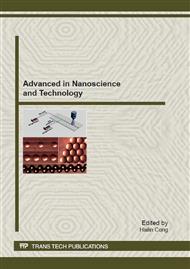p.182
p.186
p.192
p.198
p.204
p.210
p.215
p.220
p.224
Effective Method for Preparation of Surface NH2-Functionalized SBA-15 Mesoporous Silica
Abstract:
Surface NH2-functionalized SBA-15 mesoporous silica was synthesized using toluene diisocyanate (TDI) as bridge molecule. Firstly, surface Si-OH of SBA-15 reacted with one –NCO group of TDI molecular. Then, another unreacted –NCO group of TDI molecular reacted with one -NH2 group of ethylenediamine (EDA). Finally, NH2- group was successfully grafted on mesoporous SBA-15 surface by the above two step method. XRD, N2 adsorption/desorption analysis, FTIR and 29Si MAS NMR were used to identify the well-ordered structure and the successful incorporation of -NH2 on the surface of the synthesized materials. Characterizations revealed that such -NH2 graft is an effective method to obtain a high loading of amino on SBA -15.
Info:
Periodical:
Pages:
204-209
Citation:
Online since:
February 2012
Authors:
Keywords:
Price:
Сopyright:
© 2012 Trans Tech Publications Ltd. All Rights Reserved
Share:
Citation:


